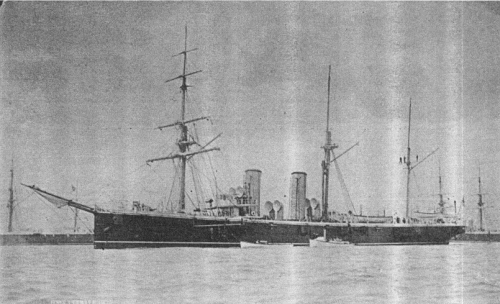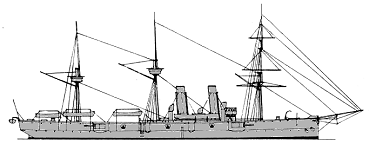
NAVYPEDIA
 Support the project with paypal
Support the project with paypal
Photo

Leander in her early days
Ships
| Name | No | Yard No | Builder | Laid down | Launched | Comp | Fate |
|---|---|---|---|---|---|---|---|
| Leander | 378 | Napier, Govan | 14.6.1880 | 28.10.1882 | 29.5.1885 | depot ship 1904 | |
| Arethusa | 379 | Napier, Govan | 14.6.1880 | 23.12.1882 | 29.9.1887 | sold to BU 4.1905 | |
| Phaeton | 380 | Napier, Govan | 14.6.1880 | 27.2.1883 | 20.4.1886 | TS 1909, sold 1913 | |
| Amphion | 207 | Pembroke DYd | 25.4.1881 | 13.10.1883 | 8.1886 | sold to BU 5.1906 |
Technical data
| Displacement normal, t | 4300 |
|---|---|
| Displacement full, t |
|
| Length, m | 91.4 pp 96.0 oa |
| Breadth, m | 14.0 |
| Draught, m | 6.25 |
| No of shafts | 2 |
| Machinery | 2 2-cyl HC, direct action, 12 cylindrical boilers |
| Power, h. p. | 5500 |
| Max speed, kts | 16.5 |
| Fuel, t | coal 1016 |
| Endurance, nm(kts) | 11000(10) |
| Armour, mm | steel; deck: 38, gunshields: 38 |
| Armament | Leander, Phaeton: 10 x 1 - 152/26 BL Mk III, 10 x 4 - 25/40 Nordenfelt Mk I, 2 x 6 - 11.4/59, 4 x 5 - 11.4/60, 4 - 356 TC Arethusa: 10 x 1 - 152/26 BL Mk II, 10 x 4 - 25/40 Nordenfelt Mk I, 2 x 6 - 11.4/59, 4 x 5 - 11.4/60, 4 - 356 TC Amphion: 10x 1 - 152/26 BL Mk IV/VI, 10 x 4 - 25/40 Nordenfelt Mk I, 2 x 6 - 11.4/59, 4 x 5 - 11.4/60, 4 - 356 TC |
| Complement | 278 |
Standard scale images

Leander 1897
Graphics
Project history
Repeats of Mercury but modified to include a protective deck and improved machinery and armament. Originally classified as despatch vessels, they were redesignated second class cruisers prior to completion. The arrangement of the hull and subdivision was as in the previous class except that the lower deck over the length of the machinery compartments (50.3m) was constructed of 38mm thick plating with sloped sides to deflect shells entering at the water-line. The 152mm guns were mounted on each side of the main deck with those furthest forward and aft fitted on central pivot mounts and the remainder on broadside mounts. The end guns were positioned in sponsons to provide ahead and astern fire and were protected by 38mm shields as defence against machine guns. After trials with the Phaeton, the funnels were raised by 1.8m to improve the draught to the boilers and subsequently all exceeded the designed speed, averaging 17-18kts on trial. The improved economy of the TE engine and an increase in the maximum coal stowage gave an endurance of 11000nm at 10kis, a substantial improvement on the Mercury which had been criticized in this respect. They were good steam vessels but poor sea boats with a heavy roll in certain conditions of sea. They carried a barque rig identical to that in Mercury and retained their yards until the late 1890s.
Ship protection
The lower deck over the length of the machinery compartments (50.3m) was constructed of 38mm thick plating with sloped sides to deflect shells entering at the water-line. Also 152mm guns had 38mm thick shields.
Modernizations
1880s, Leander, Phaeton, Amphion: - 4 x 4 - 25/40; + 4 x 1 - 47/40 3pdr Hotchkiss Mk I
1880s, Arethusa: - 8 x 4 - 25/40; + 8 x 1 - 47/40 3pdr Hotchkiss Mk I
1890s, all: barque rig was replaced by military masts
Naval service
Phaeton was sold in 1913 and became TS Indefatigable; she was repurchased in 1941 and renamed Carrick II, serving as a Royal Navy TS throughout the Second World War.
Many thanks to Wolfgang Stöhr for additional information on this page.
in her early days
 HOME
HOME FIGHTING SHIPS OF THE WORLD
FIGHTING SHIPS OF THE WORLD UNITED KINGDOM
UNITED KINGDOM CRUISERS
CRUISERS LEANDER 2 class cruisers (4, 1885 - 1887)
LEANDER 2 class cruisers (4, 1885 - 1887)
